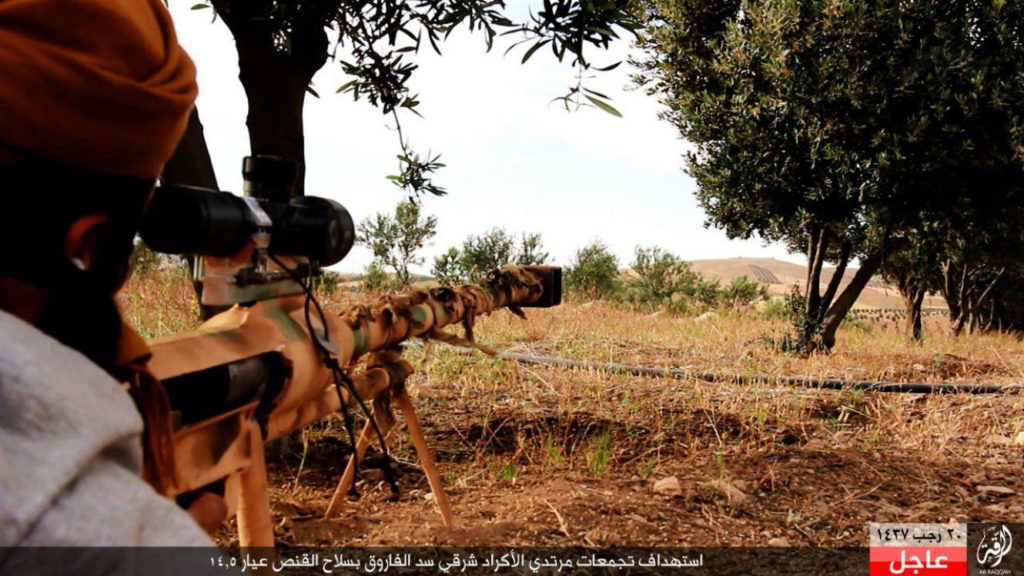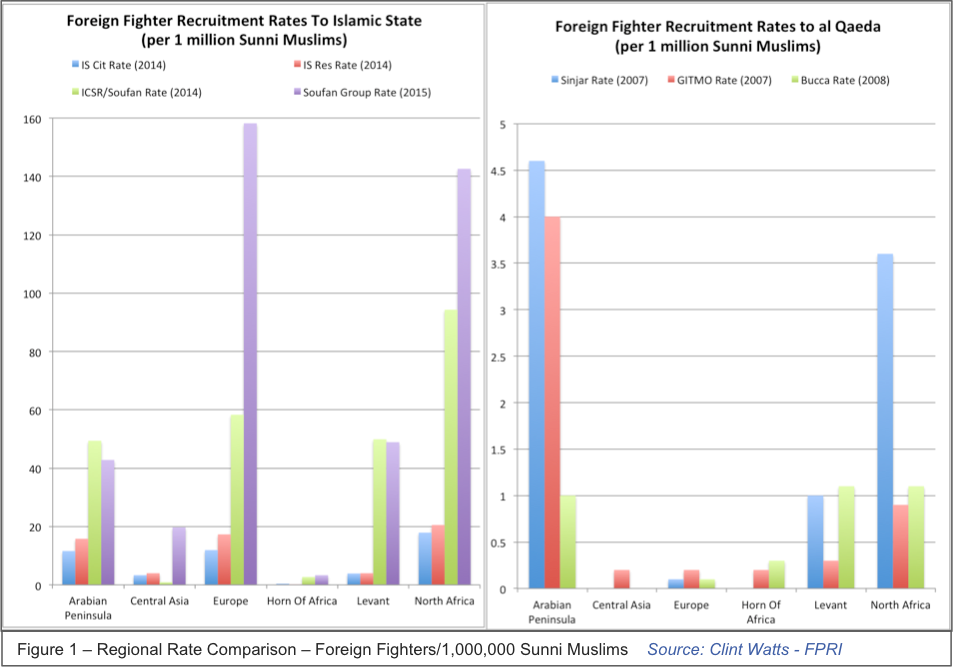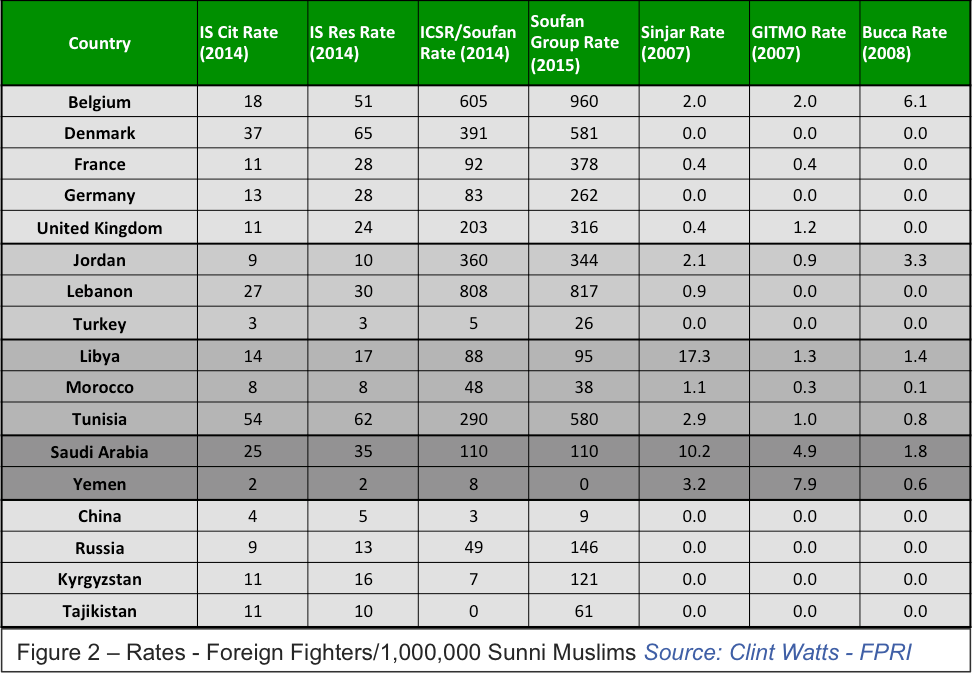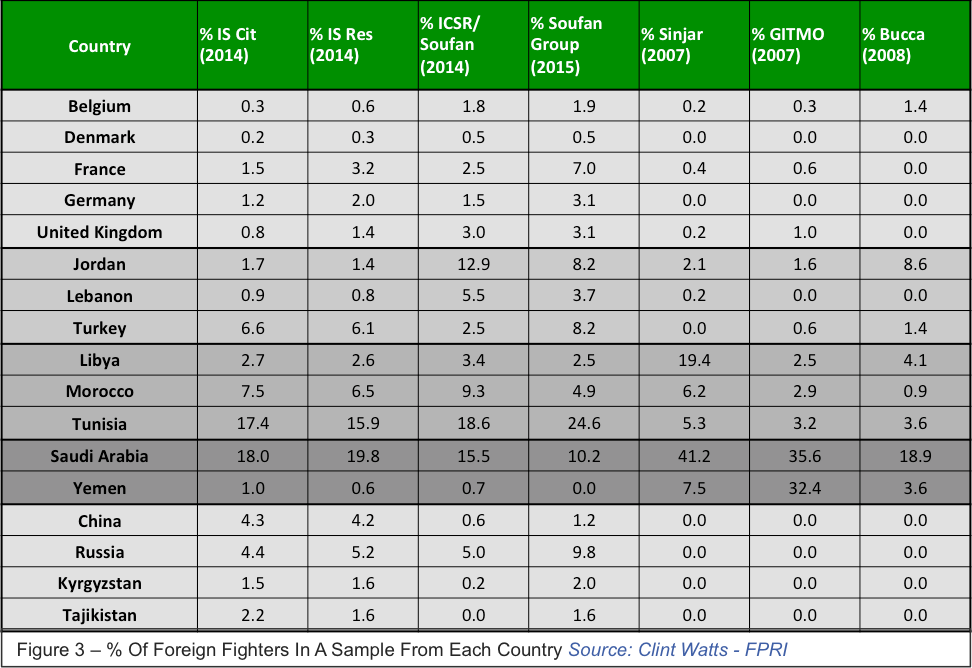Beyond Syria and Iraq, the Islamic State’s HR Files Illuminate Dangerous Trends

Thanks to the jihadi version of an Edward Snowden data dump, the Combating Terrorism Center at West Point now hosts documented evidence of who has joined the Islamic State’s ranks.When compared to other Islamic State foreign fighters estimates or to the last decade’s foreign fighter flows to Iraq, this new data shows thatEurope’s foreign fighter recruitment rate is growing far faster than that of any other region. The dangers of unaddressed foreign fighter facilitators and new foreign fighter currents spell trouble on the horizon.
The Problem with Foreign Fighter Estimates
Foreign fighter numbers to the Islamic State and al Qaeda routinely surface in the media, each larger and more alarming than the last. These estimates are fraught with analytical danger. First, they often focus on raw numbers of recruits heading off to Syria and Iraq rather than the rate of recruitment per capita. These counts, often just guesses, completely miss the point. More populous countries will almost always, and should be expected to have, the largest count of foreign fighters in a sample. Another common misstep comes when analysts calculate foreign fighter recruitment rates using a country’s total population. This too is a deceptive method by which to measure the problem. The most accurate foreign fighter recruitment comes from measuring the raw count of fighters against the Sunni Muslim population of a country, which is often a small subset of a country’s total, especially in Europe. Another set of problems arises when analysts take distinct foreign fighter samples as representative of the entire foreign fighter population. For example, the Sinjar records showing foreign fighters to Iraq provided the best source of data last decade, but it represented only one foreign fighter transit point into Iraq and only those recruits entering during 2006 and 2007. External, open-source foreign fighter estimates prior to the recent Islamic State data dump relied principally on social media aggregation and thus missed pockets of members who were physically recruited or arrived from countries where social media participation is either less common or heavily surveilled (as in Russia).
Understanding true foreign fighter trends and overcoming the challenges noted above requires examination of multiple foreign fighter samples from different time periods and collection points. Comparing each country’s rates of recruitment and proportions of fighters from this recent Islamic State archive alongside five other samples from this decade and the last illuminates several insights into the current state of jihadi participation. I compared the following six foreign fighter samples:
1. The Combating Terrorism Center at West Point recent report, The Caliphate’s Global Workforce offers summarized data of 4,600 foreign fighter personnel records amassed by the Islamic State between early 2013 and late 2014. This data provides a foreign fighter sample for country of citizenship (coded “IS Cit”) and a country of residence (“IS Res”), both of which are calculated independently in the tables found in Figure 2 and Figure 3.
2. The World Bulletin created a foreign fighter estimate using the International Center for the Study of Radicalization (ICSR) high estimates of Western Europeans along with some Soufan Group estimates. These estimates provide a useful comparison to the new Combating Terrorism Center Islamic State sample as they use data from roughly the same time period: December 2013 to October 2014.
3. The Soufan Group’s “Foreign Fighters: An Updated Assessment of the Flow of Foreign Fighters into Syria and Iraq” provided an estimate in December 2015. Official counts from this document were utilized when possible and unofficial counts if official numbers were not available. Estimates came from multiple periods in 2014 and 2015.
4. I coded the Sinjar Records in 2007 and used them to address three different analytical questions: “Beyond Iraq and Afghanistan: What Foreign Fighter Data Reveals About the Future of Terrorism”, “Foreign Fighters: How are they being recruited?” and “Countering Terrorism From The Second Foreign Fighter Glut.” The Sinjar records overrepresented foreign fighters traveling into Iraq via the western corridor of Syria, notably North Africans.
5. A 2007 CTC report offers the records of Guantanamo Bay detainees. This data shows early foreign fighter flows that include pre-9/11 recruits.
6. I have also included a sample of foreign fighters detained at Camp Bucca, Iraq that I found in 2008. This data helps balance out some of the weaknesses of the Sinjar data showing more recruits coming from the southern corridor. For an example of this difference in samples, see the “Bucca” Egypt data,
Together, these sources provided foreign fighter data from more than 90 countries. I have used these to calculate the regional foreign fighter recruitment rates in Figure 1. I then narrowed to a smaller set of more prolific countries showing the recruitment rates by country for all six sources (Figure 2) and the proportion of foreign fighters from each country found in a given sample (Figure 3) [Editor’s Note: All of the date, including the rates from all of these sources compared for every country and the percentages of recruits from each country’s Sunni Muslim population, are available at War on the Rocks].

European Foreign Fighters Showed Up Big For The Islamic State
Europe’s foreign fighter flow to the Islamic State this decade soared in comparison to al Qaeda in Iraq last decade. (Figure 1 – Regional Rate Comparison). Azerbaijan, surprisingly, ranked first in the latest Islamic State records cache. As seen with the recent Brussels attacks, small European countries have the biggest Islamic State challenge (Figure 2 – Rates). Belgium and Denmark have the highest recruitment rates in Europe and likely the lowest capacity and competency to handle this terrorist threat. The United Kingdom, France, and Germany all clocked in at roughly the same rate suggesting Islamic State affinity is pervasive across larger European countries regardless of their immigrant patterns. All European countries, whether they be Western, Balkan, or Caucasus, have shown a dramatic increase in recruitment.
At first glance, North Africa’s recruitment rate seems equally alarming to that of Europe’s (Figure 1). Last decade, North Africans showed up on a massive scale to join Abu Musab al Zarqawi’s legions in Iraq. When we compare this decade to the last in North Africa, we find there are 40 times more recruits to the Islamic State today (in Tunisia, as I discuss below, the rate of growth is the highest in the region). This seems alarming, and it is, but Europe’s rate of recruits per million Sunni Muslims is roughly 600 times greater this decade than it was the last decade. And this estimated European rise in recruitment rates may still be lower than reality.
Last round’s hotspots of Libya and Yemen, for example, showed flat comparative rates of foreign fighter production and make up a smaller proportion of this decade’s sample (Figure 3). If the Islamic State and al Qaeda have branches battling in one’s country, why travel to Syria when one can fight at home? Even Saudi Arabia, always the largest producer by gross number, showed steady or maybe even declining rates of recruitment to the Islamic State (Figure 2 & 3).

Some of ICSR’s and Soufan’s European fighter estimates show higher numbers than the Islamic State records at West Point. The difference between these samples comes from how this data was collected. For example, the ICSR and Soufan numbers for Bosnia better reflect foreign fighter tracking I observed during the 2012 timeframe. The Combating Terrorism Center at West Point noted that several hundred more foreign fighter records did not declare either a country of citizenship or a country of residence. My hypothesis is that the majority of those records missing country data are individuals from Europe that were less willing to disclose their residence.
During the Islamic State’s recruitment boom in 2013 and 2014, many European Islamic State recruits avoided showing their face in social media suggesting they might want to return home some day and thus wanted to avoid being identified by law enforcement and counterterrorism. This unwillingness faded as the Islamic State’s fame grew. I imagine many of these same recruits who were still trying to cloak their identity online were also reluctant to cough up their personal details in employment forms upon entry during this timeframe. Finding a more accurate, and potentially higher, rate of European recruitment may come eventually when a research group holding the new Islamic State records codes the phone numbers provided by recruits. When I coded the Sinjar records in 2007, phone numbers allowed for the removal of duplicate entries and provided an alternate method to vaguely place people geographically. Country codes and area codes are telling and even if the recruit avoids giving their citizenship and residence the phone details will often place them in a country. Should these cloaked entries reveal European recruits, as I hypothesize, foreign fighter recruitment rates from the recent Islamic State records will likely be double or triple what is shown in Figure 2.
What’s with Tunisia’s foreign fighter recruitment problem? Facilitation Is the Key
Tunisia sits atop the Islamic State’s recruitment charts by all foreign fighter measures: counts, rates, and proportions. Having sparked the Arab Spring and become a beacon of hope for the spread of democracy in the Arab world, Tunisia would seem to be a land of opportunity for young men that detracts from the Islamic State’s appeal. Dr. Alan Krueger, in his book What Makes A Terrorist?, noted last decade that leading correlates of terrorist mobilization are the lack of political rights and civil liberties, and I found the same results when testing Krueger’s model with the Sinjar data. Soft power counterterrorism advocates have pushed democracy and freedom for more than a decade as a silver bullet for countering radicalization, yet this most recent data may point to the inverse. Some suggest Tunisia’s democratic dream has already failed young Tunisian men who see the Islamic State’s vision as offering a better alternative to slowly developing opportunities stemming from the young democratic system, but this explanation is premature. Tunisia’s democracy may be struggling, but it has by no means failed.
Tunisia’s foreign fighter problems arise not from the missteps of Tunisia’s democratic transition but, but based upon weakened counterterrorism capacity and a legacy of foreign fighter facilitation — a critical, overlooked factor noted in Timothy Holman’s recent study. Tunisia, unlike Libya and Egypt, does not offer young men participation in a local revolution and suffers the challenges of other fledging, weak democracies. Terrorists find them more permissible grounds for recruitment as the counterterrorists prove less aggressive and capable as compared to when they operated under dictatorships.
Most importantly, last decade’s Sinjar records bore signs of Tunisia’s facilitation networks which likely regenerated quickly and mobilized young men rapidly to Syria this decade. More than all other foreign fighter facilitators, “Abu Omar al Tunisi” surfaced throughout the Sinjar records pointing to what likely became a well-oiled foreign fighter recruitment pipeline for the Islamic State. Inspired by local clerics preaching jihad, surrounded by former foreign fighters of Zarqawi’s legions, and networked by veteran facilitators on three continents who can quickly link new recruits to known pathways into Syria, Tunisia’s foreign fighter production represents a perfect storm where the best recruiter of a foreign fighter is a former foreign fighter and few impediments exist to derail one from moving between Tunis and Raqqa.

Future Jihadi Trouble: Implications of the Islamic State Foreign Fighter Records
Over the past 30 years, foreign fighters have been the thread by which one can trace jihadi violence. Committed, motivated survivors of each mobilization go on to power the next round of terrorism. Those foreign fighters that cannot or will not return home tend to join the most promising emerging affiliates abroad. Arab foreign fighters showed up in Afghanistan during the 1980s, settled in Pakistan, Sudan, and Afghanistan, and later became the backbone of al Qaeda in the 1990s. Last decade, boys from the Arabian Peninsula, alongside an upsurge of North African recruits, fought in Iraq and soon after powered terrorism across more than a half dozen terrorist affiliates, notably in Yemen and the Sahel.
Language, ethnicity, and marriage often dictate which foreign fighters congregate together as battlefields open and close. As seen in social media recruitment over the past five years, recruits are drawn to jihadi leaders that talk like them and look like them. On the battlefield, foreign fighters mingle with those whom they can communicate and identify with ethnically. French and Belgian recruits more often fall into the ranks with Moroccans, Algerian, and Tunisians. Russian speakers from the Caucasus and Central Asia join forces, as those from the Balkans band together. Germans last decade, for some reason, surfaced more often in Afghanistan and Pakistan. British and American English-speaking Somalis showed up with converts to join al Shabaab in Somalia. Foreign fighter patterns are complicated, but somewhat predictable. Examining facilitation pathways and these foreign fighter linkages will be essential for anticipating the next wave of violence.
The trends revealed in the new Islamic State records alongside lessons learned from past foreign fighter migrations point to several actions Western powers should consider to preempt the next wave of violence stemming from the Islamic State’s survivors. First, as seen by Tunisia’s massive supply of fighters, the West should move aggressively to disrupt terrorist facilitators. If left unattended, they’ll only fuel other jihadi pipelines as battlefields emerge. Second, closely track surviving European foreign fighters, many of whom are unable to return home as the Islamic State falters in Iraq and Syria. Where these trained, experienced, and committed European foreign fighters choose to migrate will prove a strong signal of where violent jihad will march next. This will also point to impending threats to European countries as their angry youth, as seen in Brussels and Paris, turn their guns on their homelands. Third, Western powers should determine whether Central Asian foreign fighters, along with Russians and Chinese, will band together as Syria closes. Regionally, Central Asia, after Europe, showed the second highest increase in recruitment rates this decade. Chinese and Russian foreign fighter migration stems not only from the opportunities of Syria, but because they’ve been squelched at home. Should Russian and Chinese fighters, who together comprise 10 percent of the recent Islamic State sample, join with their Central Asian comrades, they will become a formidable, veteran contingent that may power an Asian terrorist group in the coming years. Finally, properly assessing where European and Central Asian survivors of the Islamic State coalesce requires an equal assessment of the opportunities available to them, namely what affiliates and regions offer the best chances of survival, regeneration, jihadi glory and prosperity. Recent foreign fighter records show the ingredients for the next round of jihad, affiliates will supply the recipe.
Clint Watts is a Fox Fellow at the Foreign Policy Research Institute in Philadelphia and a Senior Fellow at the Center for Cyber and Homeland Security at The George Washington University. Prior to his current work as a security consultant, Clint served as a U.S. Army infantry officer, a FBI Special Agent on a Joint Terrorism Task Force, and as the Executive Officer of the Combating Terrorism Center at West Point.

